Array-based comparative genomic hybridization (aCGH) is an advanced technique that offers more detailed and comprehensive screening results, as it analyzes all chromosomes, including the sex chromosomes. As a result, the selection of embryos with a normal chromosomal count—free from duplications or deletions—is more accurate and reliable.
For further information or Booking..

Human Chromosomes
Humans have a total of 23 pairs of chromosomes: 22 pairs of autosomes (body chromosomes) and 1 pair of sex chromosomes. The XX combination determines the female sex, while XY determines the male sex.
What Are Chromosomes?
Chromosomes are structures that carry genetic information, located within the nucleus of cells—the smallest functional units of body tissues. They occur in homologous pairs and resemble a pair of pants in shape. Their main role is to regulate cellular functions, which in turn control how the body’s organs operate.
Each individual’s genetic traits are determined by genes, which are small segments of DNA located on each chromosome. These genes are responsible for regulating cell growth and function, and they define the unique characteristics of every person.
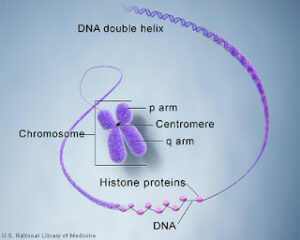
Chromosomal Structure
Egg and sperm cells each carry chromosomes, not components of chromosomes. Each gamete contains half the number of chromosomes required to form a complete genetic set. When the mother’s egg and the father’s sperm unite, they combine their genetic material to form a complete set of chromosomes in the embryo. This results in homologous pairs of chromosomes, one from each parent.
These genetic codes determine an individual’s unique traits. Even though siblings share the same biological parents, they inherit different combinations of genes, which is why each person is unique—even siblings born from the same parents.
Prenatal Genetic Testing Methods
There are several methods available today for prenatal genetic testing.
Method 1: FISH Technique (Preimplantation Genetic Screening)
This method is now considered outdated and is no longer used for chromosomal testing at Phyathai Sriracha Hospital.
The FISH (Fluorescence In Situ Hybridization) technique detects numerical chromosomal abnormalities by examining the nucleus of a single cell from an embryo. It focuses on identifying common chromosomal disorders found in newborns, such as:
- Trisomy 13 (Patau syndrome)
- Trisomy 18 (Edward syndrome)
- Trisomy 21 (Down syndrome)
It also screens for abnormalities in sex chromosomes, including:
- XO (Turner syndrome): A condition where one sex chromosome is missing, leaving only a single X chromosome.
- XXY (Klinefelter syndrome): Typically presents as male, but may be associated with developmental delays and infertility due to the absence of sperm.
- Most chromosomal abnormalities occur due to errors during egg cell development, which are more common in women over the age of 35.
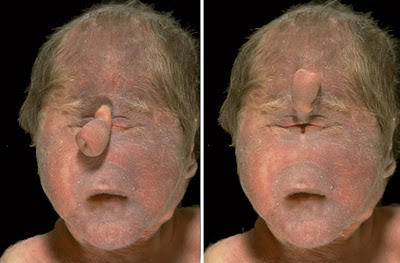
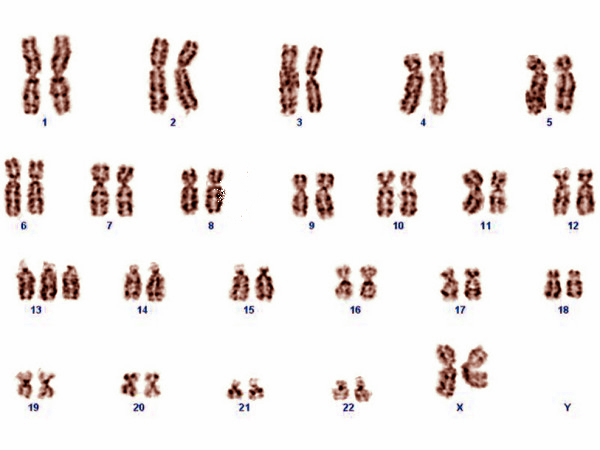
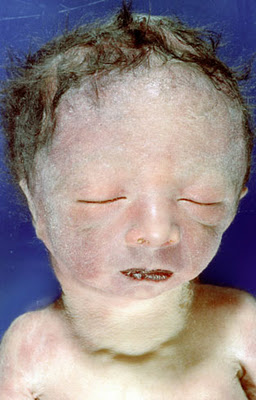
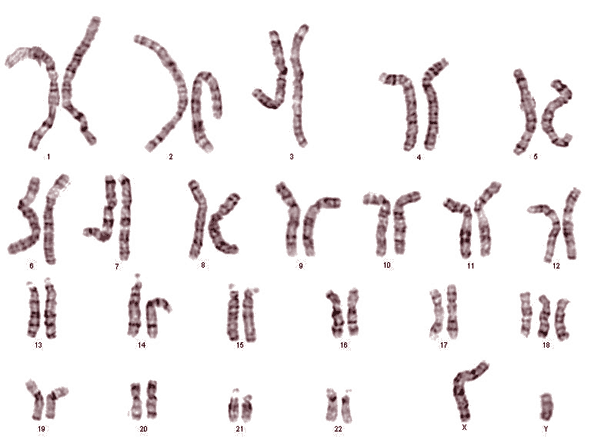



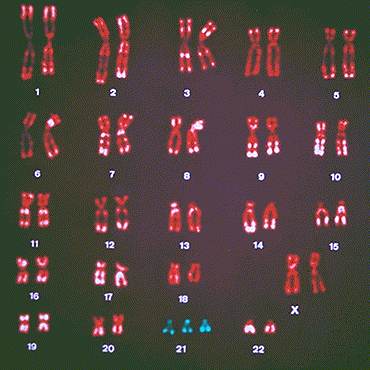
Method 2: Preimplantation Genetic Testing for Monogenic Disorders (PGT-M)
This method involves screening embryos for specific inherited genetic disorders before implantation. Only embryos without the targeted genetic mutation are selected for transfer, while affected embryos are not transferred.
A common example is thalassemia, a condition where both parents are carriers of the gene but do not show symptoms. However, their offspring may inherit the defective gene from both parents, resulting in the disease. Preimplantation genetic testing can help prevent the transmission of such disorders.
Advancements in genetic testing have replaced older techniques like FISH (Fluorescence In Situ Hybridization) with more accurate and comprehensive methods such as array Comparative Genomic Hybridization (aCGH).
Method 3: Array Comparative Genomic Hybridization (aCGH) for Higher Accuracy
In the aCGH technique, embryos are first created through in vitro fertilization (IVF). Ovarian stimulation is performed using injectable medications to produce multiple mature eggs, which are then fertilized with sperm in the laboratory.
Once fertilized, the embryos are cultured until they reach the appropriate developmental stage. A small number of cells are biopsied from each embryo—typically at the cleavage stage (6–8 cells) or at the blastocyst stage (day 5 after fertilization). These cells are analyzed using the aCGH technique to detect chromosomal abnormalities across all 23 pairs of chromosomes.
Only embryos with a normal chromosomal profile are selected for transfer to the uterus, increasing the chances of a healthy pregnancy and reducing the risk of miscarriage or congenital disorders.
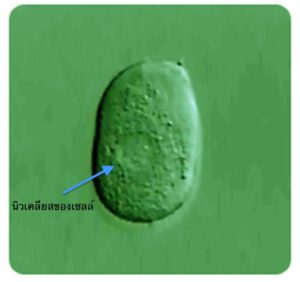
The biopsied embryos have their cytoplasm removed, leaving only the nuclei. These nuclei are then stained using the FISH (Fluorescence In Situ Hybridization) technique to count specific chromosome pairs, particularly pairs 13, 18, 21, X, and Y.
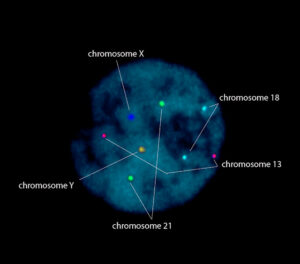
Chromosomal Testing Using the FISH Technique and Its Limitations
Image InterpretationThe image displays the nucleus of the examined embryos, showing two copies each of chromosomes 13, 18, and 21. The presence of XY sex chromosomes indicates a male embryo.
Advantages and Disadvantages of Chromosomal Testing Using the FISH Technique
- In women over the age of 35, the risk of chromosomal abnormalities increases due to potential defects in egg development. When abnormal eggs are fertilized by sperm, the resulting embryos may carry chromosomal abnormalities, which can prevent implantation or result in miscarriage within the first trimester.
- Performing chromosomal testing on embryos before transferring them into the uterus helps screen for common abnormalities found in newborns. This screening can reduce the risk of early miscarriage.
- However, retrospective studies comparing outcomes between groups that underwent chromosomal testing and those that did not have shown a lower pregnancy rate in the tested group. This reduction is likely due to potential damage to embryos during the cell biopsy process, which may result in the loss of viable embryos. Additionally, false-positive results from FISH testing may lead to the unnecessary exclusion of healthy embryos, further reducing the chances of a successful pregnancy.
- Therefore, to maximize the benefits of chromosomal testing, it should be reserved for high-risk cases—such as women over the age of 38 or individuals with a family history of chromosomal disorders like Down syndrome.
- Follow-up After ConceptionEven after achieving pregnancy, amniocentesis remains important—particularly for older mothers. While preimplantation screening tests detect a limited number of chromosomal abnormalities, amniocentesis (performed at 16–18 weeks of pregnancy) can identify abnormalities across all chromosomes.
Summary: Benefits and Drawbacks of Chromosomal Screening
Benefits:
- Reduces the risk of transferring embryos with chromosomal abnormalities in high-risk patients.
- Can help determine fetal sex in certain cases.
Drawbacks:
- Possibility of false-positive results.
- Potential reduction in pregnancy rate due to embryo manipulation and cell biopsy.
- Advanced Method: Array Comparative Genomic Hybridization (aCGH)
Phyathai Sriracha Hospital now uses an advanced method called array Comparative Genomic Hybridization (aCGH) to overcome the limitations of traditional techniques.
- This method provides comprehensive screening of all 23 pairs of chromosomes, including the sex chromosomes, with improved accuracy in identifying embryos with a normal chromosomal profile.
- The principle of aCGH involves amplifying the embryo’s genetic material to generate hundreds of thousands of DNA copies. These are then analyzed and compared to a known healthy DNA standard to detect any missing or extra chromosomal segments.
- Unlike the older FISH technique—which relies on counting colored dots on the cell nucleus and is prone to interpretation errors due to faded or overlapping signals—array CGH uses DNA microchips. The amplified DNA is hybridized onto a microarray containing reference DNA. The test results are compared to the reference: if the DNA matches the normal reference signal, it confirms a normal chromosomal structure. Any deviation indicates a gain or loss of genetic material.
- This improved technique enhances accuracy and reliability in embryo selection, increasing the chances of successful implantation and healthy pregnancy outcomes.
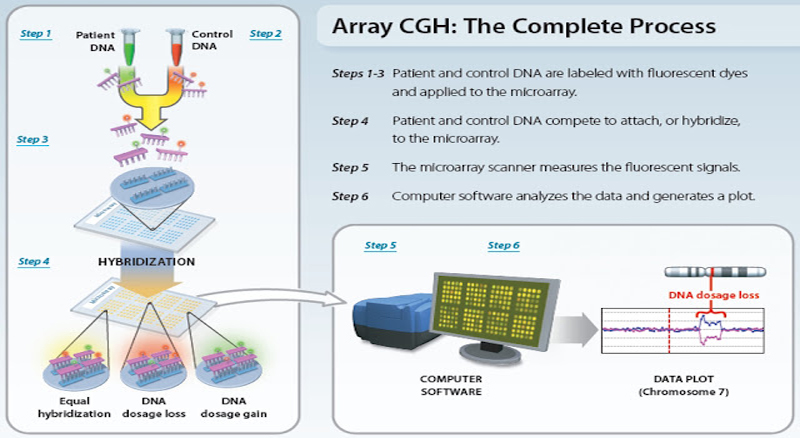
Steps of Array CGH (Comparative Genomic Hybridization)
- Step 1 & 2:
Collect DNA samples from both the embryo (or fetus) and a known standard reference DNA. These samples will be tested simultaneously, with the reference DNA serving as the control. - Step 3:
Label both DNA samples with fluorescent dyes—typically one color for the fetal DNA and another for the reference DNA. This labeling allows for visual differentiation during analysis. - Step 4:
The labeled DNA samples are mixed and hybridized onto a microarray chip that contains thousands of known DNA sequences. During hybridization, the fetal and reference DNA compete to bind to these sequences. - Step 5 & 6:
After hybridization, the microarray is scanned using a high-resolution fluorescence scanner. The intensity of the fluorescent signals is measured and analyzed using computer software. If the fetal DNA shows stronger signal intensity at specific locations compared to the reference, this indicates a gain (duplication) in that chromosomal region. Conversely, weaker signals suggest a loss (deletion) in that region.
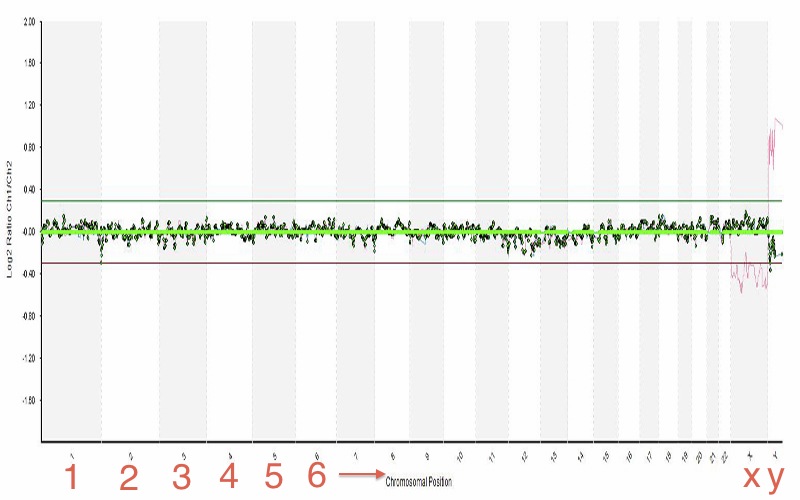
The images present the fetal genetic profile from chromosome pair 1 through 23. No segments exceed the upper green threshold (indicative of chromosomal gain) or fall below the lower red threshold (indicative of chromosomal loss), suggesting a normal chromosomal pattern.
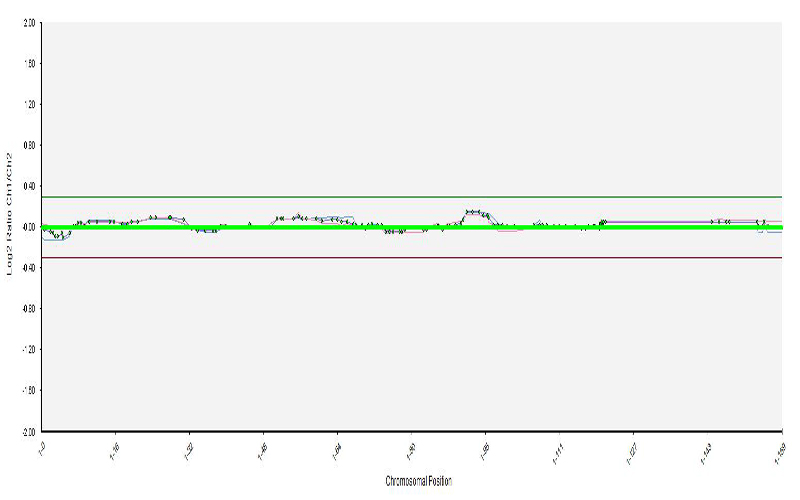
The magnified image of chromosome pair 1 allows for a more precise examination of chromosomal details compared to viewing the chromosomes as pairs, where they typically appear as shortened segments. This magnification enables the detection of small duplications or deletions at specific chromosomal positions.
The displayed video graphically illustrates the fetal chromosomal profile from chromosome pair 1 to 23. In a normal result, no segments exceed the upper boundary marked by the green line (indicating a chromosomal gain) or fall below the lower boundary marked by the red line (indicating a chromosomal loss). Additionally, each chromosome pair can be enlarged and visualized in greater detail, allowing for a clearer analysis compared to standard chromosomal overviews.
For further information or Booking..
















